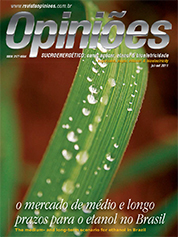Renato Augusto Pontes Cunha
President of Sindaçúcar -PE
Op-AA-29
Sugarcane of the Northeast in light of Provisional Bill (MP) 532
To be an entrepreneur in agriculture is very difficult. The activity is characterized by imponderable factors, notably as related to the climate, as well as production costs, often lacking logic, and with excessively high tax, labor and social security burdens. Monitored planning formulates concrete perspectives, mainly as related to infrastructure in existing areas and on agricultural frontiers yet to emerge, in comparison with Brazil’s food and agro-energy demand projections, in a sustainable manner, in all regions.
In our region, Northeastern Brazil, it is essential to have a policy that fosters continuous verticalization of productivity, from Sergipe to Rio Grande do Norte, and also expansion, for instance in the East of the States of Bahia and Pernambuco, in Alagoas, in the agricultural region of the São Francisco River, in Piauí, Maranhão, Ceará, Paraíba and in all states of a region that has a population of more than 53 million consumers.
To conclude the debate on the Forest Code in the Senate, and to formally aim for an updated and contemporary labor agenda, are indispensable requisites, whereas it is essential that the Code conciliate production and the generation of income, obviously respecting the inter-temporality of the laws, bringing about legal security to who is an entrepreneur based on profitability, ethics and social responsibility.
Current legal insecurity, which insists on wanting to criminalize those who went about being entrepreneurs in accordance with legislation in force, in combination with the subjectivity of several labor concepts contained in norm nr. 31 of the Ministry of Labor and Employment, are actually factors inhibiting production growth.
In agro-energy of advanced bioethanol from sugarcane, a respectable pollution reducing system in countries whose aim is low carbon, threats to their macro-contexts are growth inhibitors, even in a market whose outlook is a promising one, with latent demand.
It is appropriate to mention that the sugarcane planter gets his compensation according to the “Consecana” model, with payment based on a partnership in which payouts are made to planters, by companies, at the price levels achieved when selling end-products.
Considering farmers with own sugarcane, sugarcane cooperatives, mills and distilleries with own sugarcane, there are more than 60,000 agents and planters that generate more than 1 million formal and direct jobs, with the resulting revenues in a robust agro-cluster, and with investments in productivity, technology and capital goods. Costs, therefore, are certain and weigh heavily, whereas revenues are more prone to variation, even with the efficient hedging in futures’ markets.
For the 2019/2020 harvest, projections show a market potential of more than 1 million tons of sugarcane, which would imply the (to a certain degree utopist) actual growth of more than 400 million tons, with room to double production, also by means of productivity gains. Thus, there would be an opportunity for private initiative, the Federal Government and also fuel distributors, to come up with an efficient and sustainable project.
Currently, ethanol sales prices, paid by the distributor to the producer, do not pay-off. Even so, the production mix projected for the current season (2011-2012 harvest) is at 54% of cane juice to produce ethanol and 46% to produce sugar.
Hence, what is essential and needs to be addressed by the Federal Government and duly focused on is the gap between the prices of ethanol at the mills, considering the historical averages, in comparison with the prices at which the product reaches the consumer.
The revenue balance in the production chain may improve if the ethanol producer can sell, albeit alternatively, to the retail outlet (gas station). What does it mean to be a fuel distributor? How much money in needed to invest in inventory? To be a distributor, does one need to have one’s own storage tanks? Does it suffice to buy “spot”, regardless of contractual terms? Such are the issues the ANP surely will face with the coming into force of Provisional Bill (MP) 532, currently under analysis by the National Congress.
The production chain of sugarcane in the Northeast will continue to cooperate in the supply, even while currently being responsible for only 10% of the country’s sugarcane production. However, the region performs supplementarily to the production of the Southeast at the time of harvesting, helping to minimize the shortfall caused by seasonality in the supply of end-products.
The region is the best and most rational alternative for public policy incentives. All that is needed is isonomy for a certain time period, relative to non-payback grants such as the PEPROS, PROPS, and PEPS programs, by which the Federal Government spends on the mechanization of cultures.
The attractiveness of the Northeast’s port logistics, less inefficient than that of the Center-Southern region, and the prospect of the mechanization of a larger share of the sugarcane harvest in areas on slopes, progresses with private investments.
Research in genetic improvement, through the RIDESA knowledge network, is progressing, with agricultural productivity having increased by about 20% in the last five years, and thus the time will come for us to reap the fruit of our labor, particularly from private self-management, which has been applied since the demise of tutelage by the former IAA institute at the end of the 1980’s.




